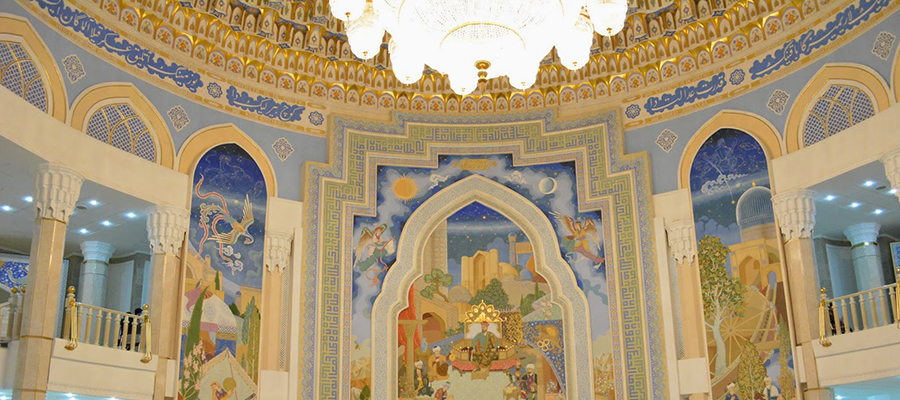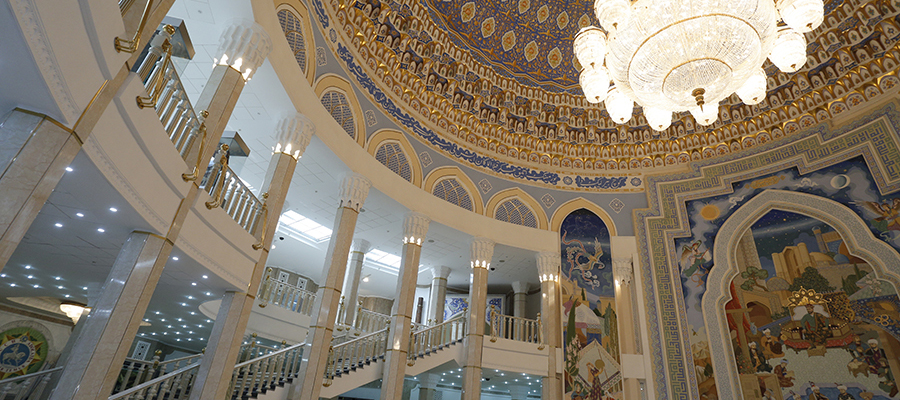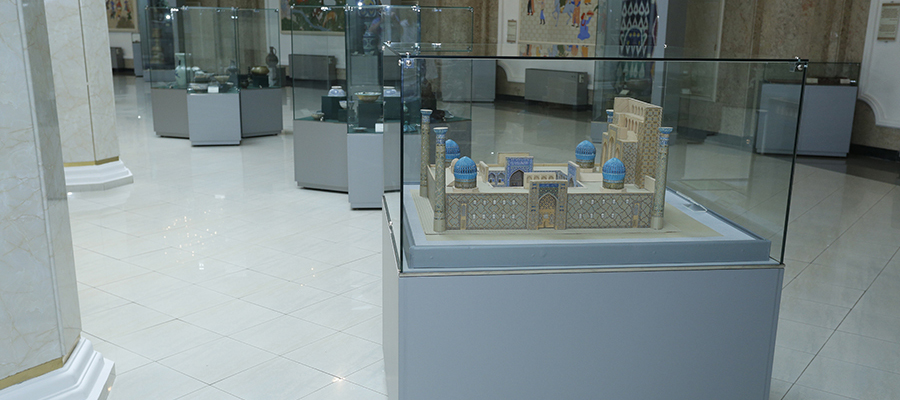Origin
Since Uzbekistan became independent in 1991, great attention was paid to revive the nation's spiritual and cultural heritage, including historical persons who had an important role in world civilization. Among those was Amir Temur, the warlord, politician and reformer, patron of science, education, trade, culture and craft. Having established a great centralized state, he strengthened its power and greatness, and also united many nations and people. Amir Temur's rule promoted science, education, culture, architecture, the fine arts, music and poetry, laying the foundations of the Temurid Renaissance.
President Islam Karimov has encouraged celebration of Timur, linking the Mongol ruler's achievements with the President's own style of governing.[2][3] Karimov declared 1996 to be the “Year of Amir Temur”, and the 660th anniversary was widely celebrated in Uzbekistan. Resolution 99 of the Cabinet of Ministers of the Republic of Uzbekistan dated March 14, 1996 was to build a State Museum in central Tashkent, featuring the Temurids' history.
Opening
Ceremonial opening of the museum was held on October 18, 1996 in the presence of Uzbek people and foreign guests. President Karimov stated that, “The State Museum of the History of the Temurids which is opening in such a holiday conditions is the real result of the fact that in our country the historical justice towards the personality of Sahibkiran has triumphed”. He mentioned that one can say with certainty, “If to compare Amir Temur Square with a wonderful ring in this case the Museum is a precious stone decorating it”.
Then President said, “Every man visiting this museum can make sure to my words, that this museum like a great mirror, reflects both our past and present and our great future”.
The building
The museum's blue cupola resembles that of the Gur-i Amir mausoleum in Samarkand. Though the museum was built according to the traditions of medieval architecture, it satisfies all modern requirements.
Today there are more than 5000 artifacts in the museum fund. Over 2000 objects are displayed in museum exhibition halls.
Exhibits
In particular, the expositions of museum display genealogy of Amir Temur, his coming to power, military campaigns of Sahibkiran, diplomatic and trade relations, workmanship, city improvement and landscaping, science and education development, and also exhibits related to representatives of Temurids' dynasty (these are different maps, weaponries, copper and silver coins, miniatures, rare manuscripts, potteries, jewelries and etc.). Models of lofty architectural constructions of Amir Temur and Temurids' era are exposed: Ak - Saray, Ahmad Yassavi`s mausoleum, Bibi - Khanum mosque, Ulughbek’s madrasah and observatory, Gur-i Amir and Taj Mahal mausoleums. The exhibition begins with the speech of President Karimov about feeling of deep respect towards historical figure Amir Temur, and also the hall is enriched with exhibits, and some phrases from “Institutes of Temur”.
At the exhibition «Gifts» are presented copies of Amir Temur's appearance gifted from the Louvre Museum of France, some samples of correspondences of Amir Temur and Temurids dynasty with neighboring countries from embassy of Iran, and also there exposed presents from embassies of Pakistan, China, Malaysia, Kazakhstan, Russia, Georgia, Turkey and others, and also there are presents of our compatriots. One can be witness of it closely acquainted with exhibition «Gifts».
Visitors
The museum now attracts over 2 million visitors each year. The museum is visited by foreign statesmen and official delegations, they being acquainted with the history of Amir Temur and Temurids' epoch are completely satisfied. During this period the museum was visited about 800 official delegations, and closely acquainted with the history of Temurids era, they recorded their impressions in the "Guest Book", on the basis of which the museum founded the exhibition "Autograph notes”.
At the museum along with the main exposition were created exhibits as «Autograph notes», «Pages of Amir Temur`s life», «Citadel Shohrukhiya - the rarest monument of Temurids epoch», «Samarkand is aged 2750», «Gifts», and «The Temurids' architectural constructions».
International links
Through participation in international exhibitions the museum has promoted its material and spiritual heritage world over. In particular, unique exhibits were displayed at the international exhibitions as «Temurids' Renaissance» in France; «Expo-2000» in Hannover (Germany); «Bright colors: fabrics and ceramics from Central Asia» in Powerhouse Museum of Sydney (Australia). At the museum were implemented collaborative exhibitions as «Rare manuscripts» with Embassy of India in Uzbekistan, «Miniature painting of Amir Temur and Temurids' era» with Embassy of Iran, exhibition «Distant and near Oman» with National Department of Documents and Archive of Oman Sultanate.
Education and research
The museum carries out educational work with the younger generation, inculcating respect and love towards their heritage, history, and great historical figures. To this end the museum holds spiritual-enlightenment activities in collaboration with schools, collages and lyceums.
The museum is also a scientific centre for studying the history of Amir Temur and Temurids` epoch, history of Uzbek state, and the Uzbek national heritage.
Major task of today is to get deep knowledge of native history, educating the younger generation in the spirit of patriotism and national pride, our state pays main attention to deep and all – round studying the history of that time, and also to its propaganda. Proceeding from requirements of today and the main subject for the last years at the State Museum of the Temurids' history were implemented two fundamental researches: «Renaissance of the Temurid's era» (2002-2006); «Studying of written monuments of Temurids' era in Uzbekistan and abroad». In addition to that younger scientists successfully finished fundamental research project on theme: «Spreading of cultural and spiritual heritage abroad, connected with the history of Uzbekistan and its role in our history»; scientific applied research on theme : «Citadel Shohrukhiya - the rarest monument of Amir Temur and Temurids' epoch»; «Tashkent is the capital of Islamic culture»; innovative project «History of Uzbekistan» (reader) 3rd vol.; «From the history of book art in Uzbekistan» (based on handwritten and lithographed copies of works created in the era of the Temurids); «Textbooks published by lithographic method at the late of nineteenth - early twentieth centuries»; «Virtual exhibitions and their scientific and practical grounds» (based on exhibitions of the State Museum of the Temurids’ History); «Military art of Amir Temur and Temurids epoch». All these researches were implemented under support of Fund innovative researches.
Today the museum successfully carries out the fundamental research project on theme: «Human significance of studying and propaganda of development science, education and culture of Temurids' epoch». The mentioned fundamental research is closely linked to scientific projects which demonstrated at the walls of the museum. Major purpose is to display reached successes in this sphere, and also scientific and educational significance of studying this research in Uzbekistan and in worldwide scale. In this research work is planned to study the given theme in republic and abroad, under corresponded publications, and also in instance of historical monuments. Among major and topical directions of today are studying and propaganda during the independence years in Uzbekistan and abroad human significance of science, culture and education of the Temurids era; proceeding from the project is determined to study and analyze foreign publications; spreading cultural relics of the Temurids epoch in worldwide scale, and also their position in worldwide culture; broad enlightenment of science, culture and education of the Temurids epoch in Internet.
It is planned to develop the museum into one of the main spiritual-enlightenment and scientific centres in the republic, studying and disseminating the history of Amir Temur and Temurids' epoch; enrich expositions illuminating cultural relics of the Temurids' era; closely collaborate with foreign museums; and create bilateral exhibitions.












